Initial Student Attention-Allocation and Flight-Performance Improvements Based on Eye-Movement Data
Abstract
:1. Introduction
1.1. Research Background and Study Significance
1.2. Objectives and Assumptions
2. Materials and Methods
2.1. Subjects
2.2. Equipment
2.3. Experimental Procedure
2.4. Data Acquisition
2.4.1. Methods of Eye-Movement Data Acquisition and Analysis
2.4.2. Flight Data Acquisition and Analysis Methods
2.5. Data Sources for the Experimental and Control Groups
2.5.1. Flight Data Acquisition and Analysis Methods
2.5.2. Training Data for the Control Group
3. Results
3.1. Analysis of the Differences between the Three Groups of Subjects
3.1.1. Flight Performance Differences between the Three Groups
3.1.2. Eye-Movement Index Differences between the Three Groups
3.2. Entropy of Fixation
3.3. Correlation between Flight-Performance Indicators and Eye-Movement Indicators
4. Conclusions
- During the no-power stall course, the instructors gazed longer at the tachometer than did the students, while they spent less time gazing at other instruments. This discrepancy can be attributed to the instructors’ deeper understanding of the instruments and their more accurate information processing.
- In the initial pilot sample data, a significant correlation was observed between the flight performance and the attention distribution. The correlation coefficients of horizontal status indicator, stall recovery time and heading offset are 0.609 and −0.7 respectively, the correlation coefficients of airspeed indicator and lost speed are −0.615, and the correlation coefficients of lost altitude and vertical speed indicator and altimeter are −0.667 respectively and −0.521. Specifically, longer gaze durations with respect to the horizontal status indicator during stall recovery were associated with longer stall durations and smaller course deviations. Similarly, longer fixation times on the airspeed indicator were associated with smaller speed losses, while longer gaze durations with respect to the vertical speedometer and the altimeter were associated with smaller altitude losses.
- The attention-allocation training course implemented by the institute significantly improved the flight performance of the trainees. The difference between the trainees in the experimental group and the instructors in the attention distribution training is only in the gaze time of the airspeed indicator (p = 0.011), and there are more differences in flight performance in the control group than in the experimental group and the instructors (lost speed, p = 0.01). An analysis of the eye-movement-index data of the experimental group of students showed that the attention-distribution patterns of these students were more similar to those of the instructors after the training, and its instrument scanning was more strategic. Consequently, the flight performance of the experimental group of students surpassed that of the control group of students.
Author Contributions
Funding
Institutional Review Board Statement
Informed Consent Statement
Data Availability Statement
Conflicts of Interest
References
- Adam, G.; Condette, J. Study on Aeroplane State Awareness during Go-Around; Bureau d’Enquetes et d’Analyses pour la Securite de L’Aviation Civile: Le Bourget, France, 2013. [Google Scholar]
- Federal Aviation Administration (FAA). Operational Use of Flight Path Managements Systems; Final Report of the Performance Based Operations Aviation Rulemaking Committee; Commercial Aviation Safety Team Flight Deck Automation Working Group: Washington, DC, USA, 2013.
- International Air Transport Association (IATA). Guidance Material for Improving Flight Crew Monitoring; International Air Transport Association: Geneva, Switzerland, 2016. [Google Scholar]
- Lefrancois, O.; Matton, N.; Gourinat, Y. The role of Pilots’ monitoring strategies in flight performance. In Proceedings of the European Association for Aviation Psychology Conference, Cascais, Portugal, 26–30 September 2016. [Google Scholar]
- Meinhardt-Injac, B.; Persike, M.; Meinhardt, G. Holistic face perception in young and older adults: Effects of feedback and attentional demand. Front. Aging Neurosci. 2014, 6, 291. [Google Scholar]
- Tsotsos, J.-K.; Abid, O.; Kotseruba, I. On the Control of Attentional Processes in Vision. Cortex 2021, 137, 305–329. [Google Scholar]
- Goettker, A.; Gegenfurtner, K.-R. A change in perspective: The interaction of saccadic and pursuit eye movements in oculomotor control and perception. Vis. Res. 2021, 188, 283–296. [Google Scholar]
- Carlos, H.; Morimoto; Marcio, R.-M. Eye gaze tracking techniques for interactive applications. Comput. Vis. Image Underst. 2005, 98, 4–24. [Google Scholar]
- Kovacsova, N.; Vlakveld, W.-P.; Winter, J. PC-based hazard anticipation training for experienced cyclists: Design and evaluation. Saf. Sci. 2019, 123, 104561. [Google Scholar]
- Tad, T.; Nallamothu, B.-K.; Elmore, J.-G. Eye-tracking for assessing medical image interpretation: Apilot feasibility study comparing novice vs expert cardiologists. Perspect. Med. Educ. 2019, 8, 65–73. [Google Scholar]
- Borg, L.-K.; Harrison, T.-K. Preliminary Experience Using Eye-Tracking Technology to Differentiate Novice and Expert Image Interpretation for Ultrasound-Guided Regional Anesthesia. J. Ultrasound Med. 2018, 37, 329–336. [Google Scholar]
- Koury, H.-F.; Leonard, C.-J.; Carry, P.-M. An Expert Derived Feedforward Histology Module Improves Pattern Recognition Efficiency in Novice Students. Anat. Sci. Educ. 2019, 12, 645–654. [Google Scholar] [PubMed]
- Meyer, J.; Fasold, F.; Schul, K. The Defender’s Vision-Gaze Behavior of One-on-One Defenders in Basketball. J. Sport Exerc. Psychol. 2022, 44, 127–137. [Google Scholar]
- Sheridan, H.; Reingold, E.-M. Chess players’ eye movements reveal rapid recognition of complex visual patterns: Evidence from a chess-related visual search task. J. Vis. 2017, 17, 4. [Google Scholar]
- Song, C.-C. A Study on the Fixation Pattern of Civil Aviation Cadets Based on Eye Movement Analysis; Civil Aviation University of China: Tianjin, China, 2014. [Google Scholar]
- Schriver, A.-T.; Morrow, D.-G.; Wickens, C.-D. Expertise differences in attentional strategies related to pilot decision making. Hum. Factors 2008, 50, 864–878. [Google Scholar] [CrossRef]
- Hsu, C.-K.; Lin, S.-C.; LI, W.-C. Visual movement and mental-workload for pilot performance assessment. Eng. Psychol. Cogn. Ergon. 2015, 9174, 356–364. [Google Scholar]
- Liu, Y.W.; Guo, X.; Lv, Q. Study on the difference of pilot simulated instrument approach fixation characteristics based on expert-novice paradigm. J. Saf. Environ. 2021, 21, 2086–2092. [Google Scholar]
- Zhu, G. Study on the Characteristics of Eye Movement during Simulated Approach Flight; Civil Aviation University of China: Tianjin, China, 2020. [Google Scholar]
- Wu, X.L.; Sun, Y.; Tang, Y. The association effect of industrial data chart presentation style with visual physiological cognitive performance such as gaze/pupil. Ind. Eng. Manag. 2023, 28, 9–16. [Google Scholar]
- Wang, A.-R.; Lv, J.; Liu, X. The influence of attention allocation strategies on interface task performance and visual behavior. Comput. Syst. Appl. 2022, 31, 11. [Google Scholar]
- Chen, M.-X.; Bai, X.-J. The effect of event rates on visual search of medical images for expert and novice radiologists: Evidence from eye movements. Psychol. Behav. Res. 2017, 15, 302–308. [Google Scholar]
- Zhu, Z.-Y.; Qian, Y.; Wang, J.; Yi, X.-J. Research on flight training quality evaluation based on time series similarity. Flight Mech. 2021, 39, 75–81. [Google Scholar]
- Yang, C.; Liu, Z.; Zhou, Q. Analysis on Eye Movement Indexes Based on Simulated Flight Task. In International Conference on Engineering Psychology and Cognitive Ergonomics; Springer: Cham, Switzerland, 2014. [Google Scholar]
- Chen, B.; Cao, B.-S.; Yu, G.-H. Analysis of pilot eye movement characteristics under single fire failure situation. J. Saf. Environ. 2019, 19, 1282–1287. [Google Scholar]
- Wang, Y.-Q.; Li, R.; Ding, D. Analysis of motion inference ability of civil aviation cadets based on eye movement data. Sci. Technol. Eng. 2020, 20, 1238–1242. [Google Scholar]
- Liu, Z.-F.; Chen, C.-Y.; Su, Y.-Q. Usability evaluation of aircraft instrument display systems: Eye movement and performance data evidence. Aerosp. Med. Med. Eng. 2018, 31, 341–346. [Google Scholar]
- Rudi, D.; Kiefer, P.; Raubal, M. Visualizing pilot eye movements for flight instructors. In Proceedings of the 3rd Workshop on Eye Tracking and Visualization Proceedings, Warsaw, Poland, 14–17 June 2018. [Google Scholar]
- Lounis, C.; Peysakhovich, V.; Causse, M. Visual scanning strategies in the cockpit are modulated by pilots’ expertise: A flight simulator study. PLoS ONE 2023, 16, e0247061. [Google Scholar] [CrossRef] [PubMed]
- Shao, F.; Lu, T.-J.; Wang, X.-C. The influence of pilot’s attention allocation on instrument reading during take-off: The mediating effect of attention span. Appl. Ergon. 2021, 90, 103245. [Google Scholar] [CrossRef]
- Ledegang, W.-D.; Groen, E.-L. Spatial Disorientation Influences on Pilots’ Visual Scanning and Flight Performance. Aerosp. Med. Hum. Perform. 2018, 89, 873–882. [Google Scholar] [CrossRef]
- Muehlethaler, C.-M.; Knecht, C.-P. Situation Awareness Training for General Aviation Pilots using Eye Tracking. Ifac Pap. 2016, 49, 66–71. [Google Scholar] [CrossRef]
- Li, W.-C.; Yu, C.-S.; Braithwaite, G. Pilots’ Attention Distributions Between Chasing a Moving Target and a Stationary Target. Aerosp. Med. Hum. Perform. 2016, 87, 989–995. [Google Scholar] [CrossRef]
- Haslbeck, A.; Zhang, B. I spy with my little eye: Analysis of airline pilots’ gaze patterns in a manual instrument flight scenario. Appl. Ergon. 2017, 63, 62–71. [Google Scholar] [CrossRef]
- Ryffel, C.-P.; Muehlethaler, C.-M.; Huber, S.-M. Eye tracking as a debriefing tool in upset prevention and recovery training (UPRT) for general aviation pilots. Ergonomics 2019, 62, 319–329. [Google Scholar] [CrossRef]
- Skvarekova, I.; Skultety, F. Objective Measurement of Pilot’s Attention Using Eye Track Technology during IFR Flights. Transp. Res. Procedia 2019, 40, 1555–1562. [Google Scholar] [CrossRef]
- Ziv, G. Gaze Behavior and Visual Attention: A Review of Eye Tracking Studies in Aviation. Int. J. Aviat. Psychol. 2016, 26, 75–104. [Google Scholar] [CrossRef]
- Wang, Q.; Hoi, S.; Wang, Y.; Song, C. Out of mind, out of sight? Investigating abnormal face scanning in Autism Spectrum Disorder using gaze-contingent paradigm. Dev. Sci. 2020, 23, e12856. [Google Scholar] [CrossRef]
- Vlacic, S.; Knezevic, A.; Mandal, S. Improving the pilot selection process by using eye-tracking tools. J. Eye Mov. Res. 2019, 12, 4. [Google Scholar]
- Lefrançois, O.; Matton, N.; Causse, M. Improving Airline Pilots’ Visual Scanning and Manual Flight Performance through Training on Skilled Eye Gaze Strategies. Safety 2021, 7, 70. [Google Scholar] [CrossRef]

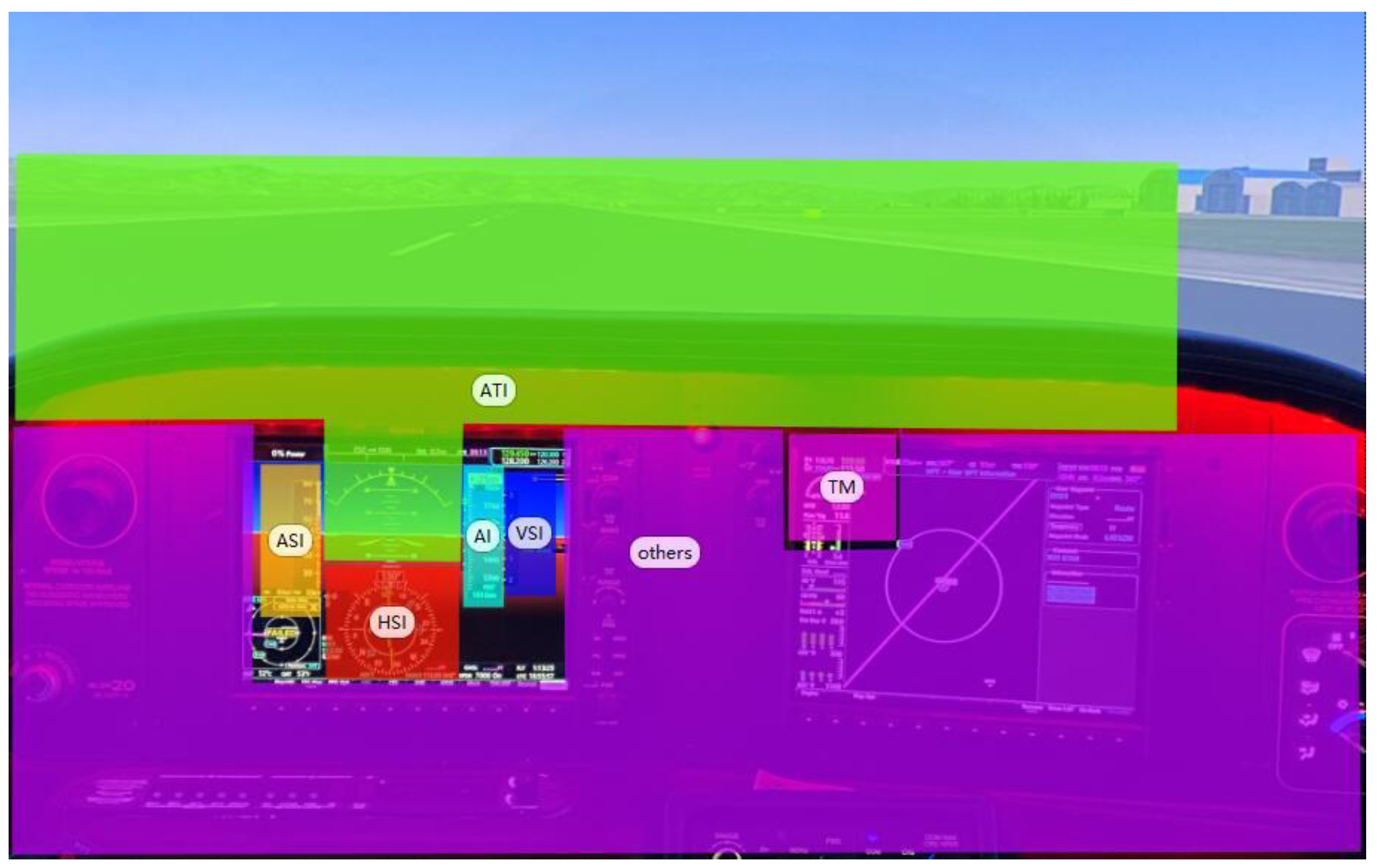
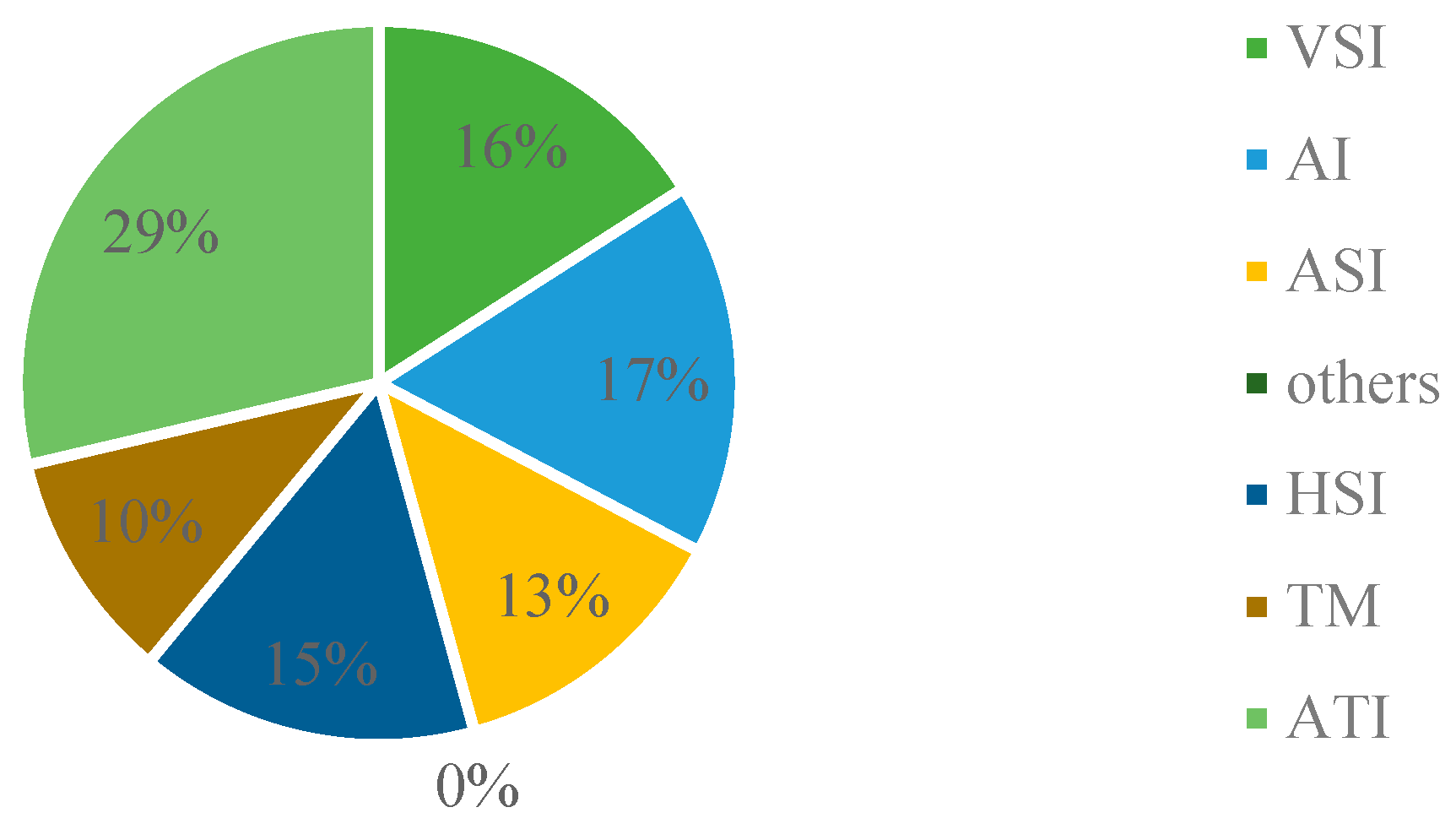

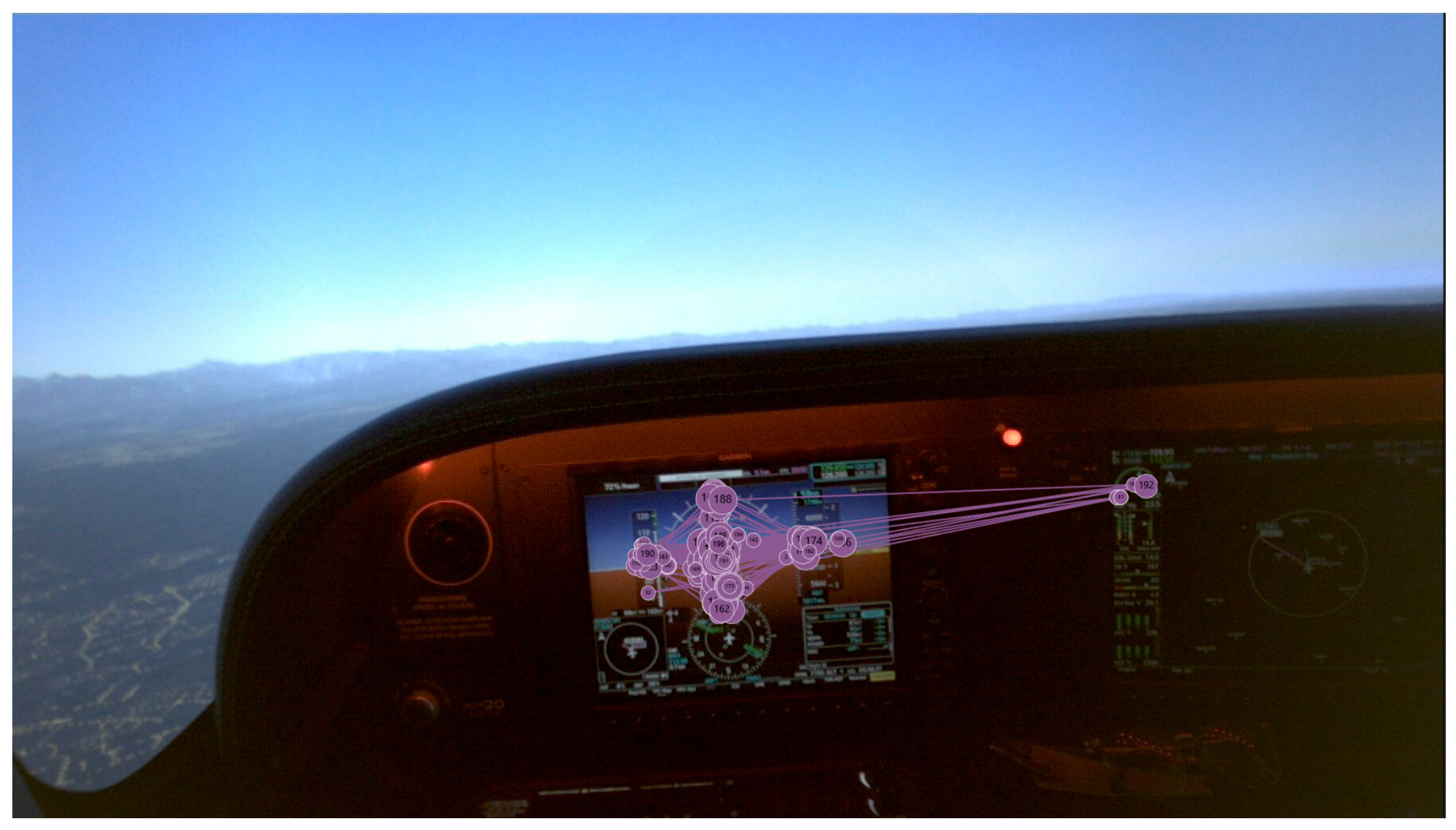
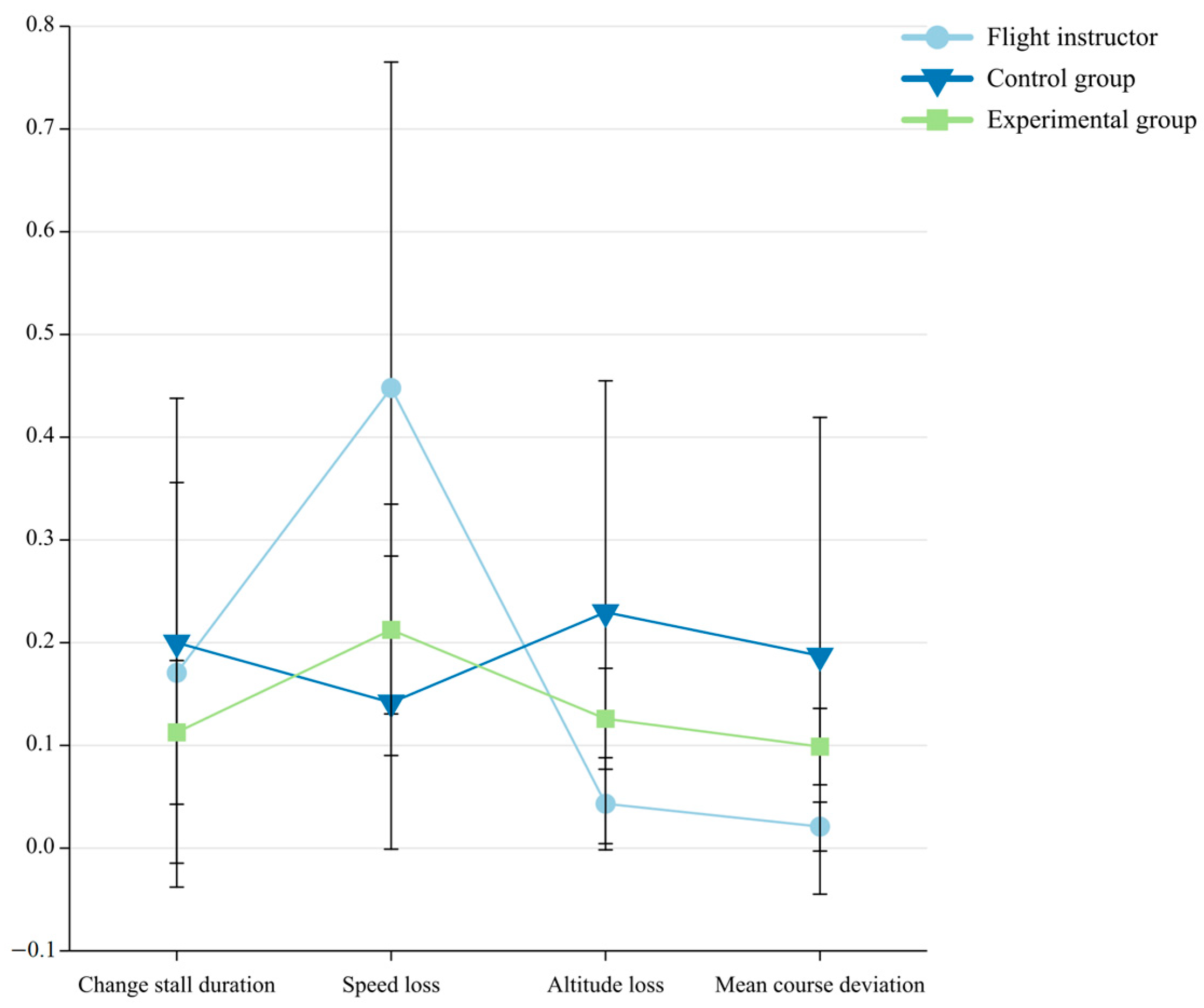
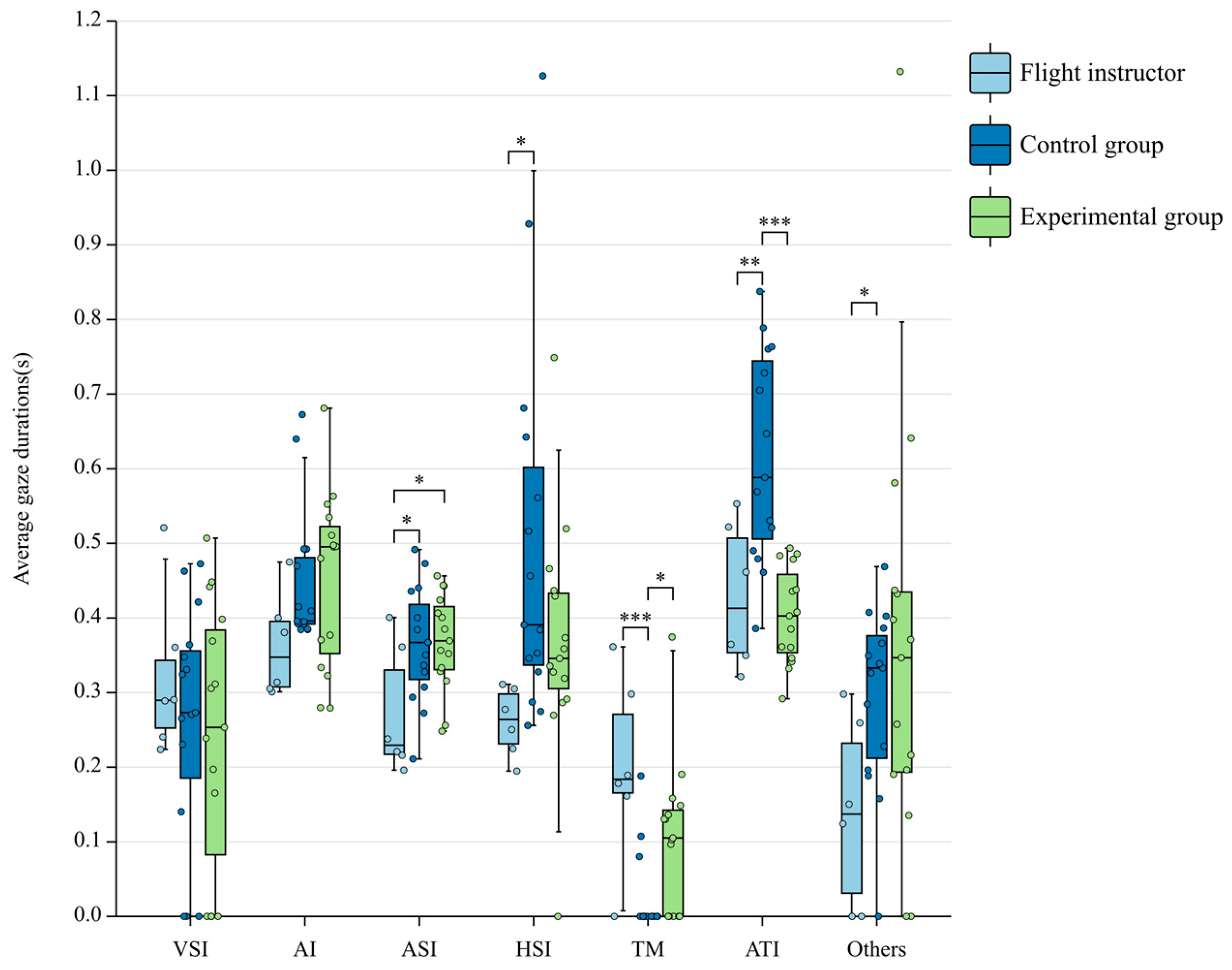
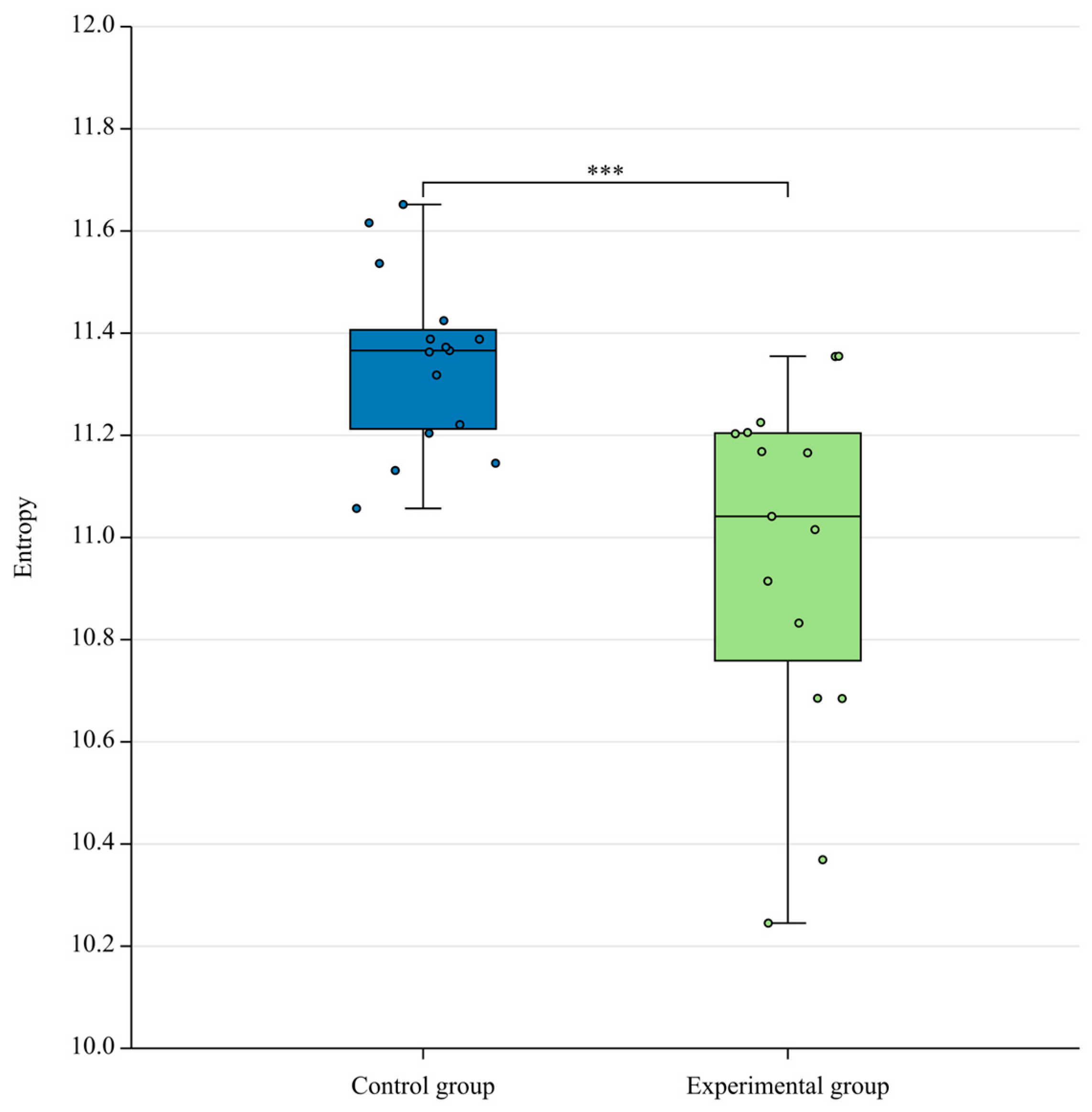
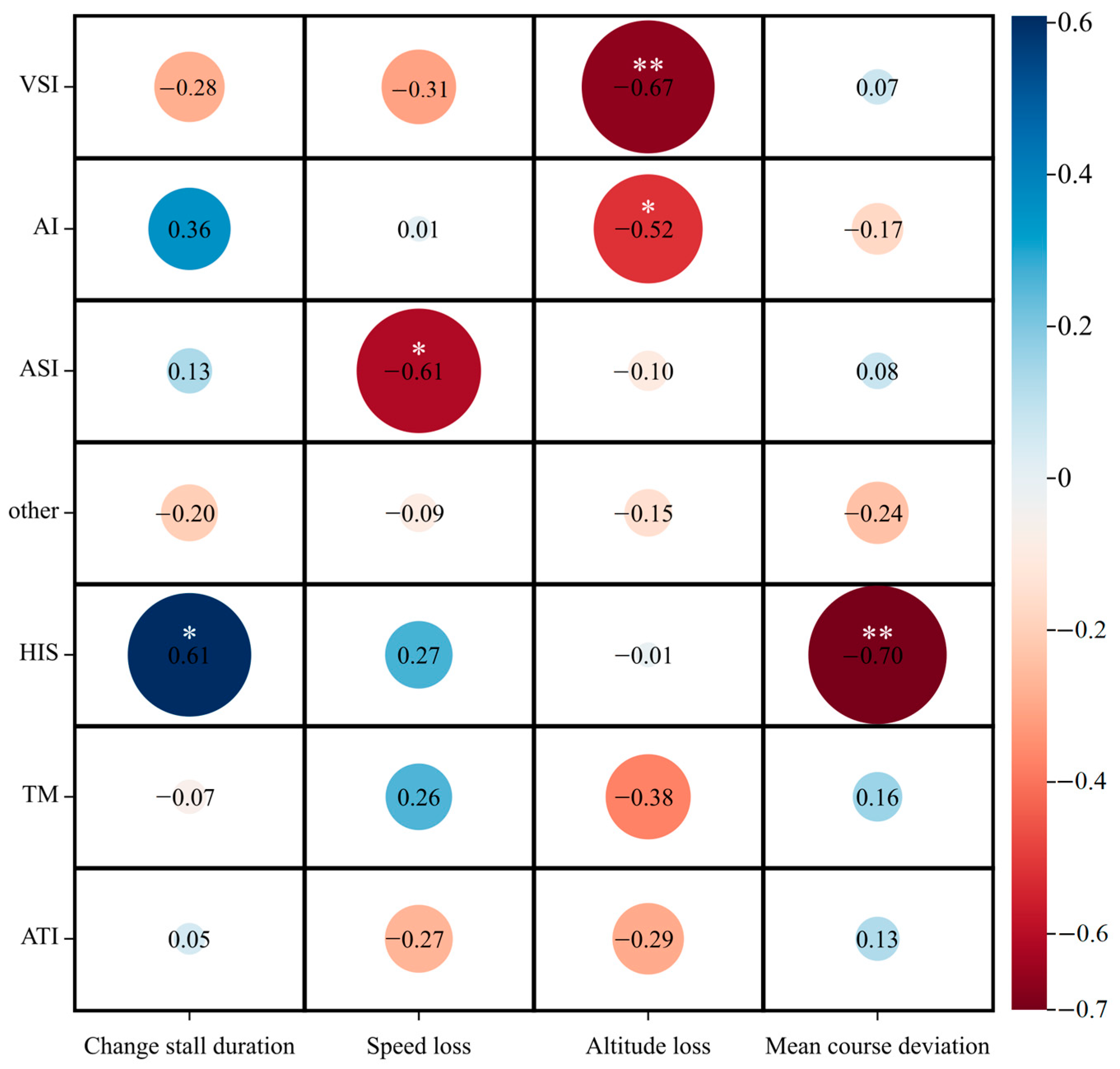
| Group | Indicator | Median Comparison | p-Value |
|---|---|---|---|
| Instructors–Control group | Stall-recovery duration | 6.25 s, 7.00 s | 0.814 |
| Speed loss | 8.00 knots, 4.00 knots | 0.010 * | |
| Altitude loss | 160.0 ft, 250.0 ft | 0.004 ** | |
| Mean course deviation | 2.67°, 7.78° | 0.001 ** | |
| Instructors–Experimental group | Stall-recovery duration | 6.25 s, 6.00 s | 0.844 |
| Speed loss | 8.00 knots, 5.00 knots | 0.050 | |
| Altitude loss | 160.0 ft, 200.0 ft | 0.006 ** | |
| Mean course deviation | 2.67°, 5.97° | 0.001 ** | |
| Control group–Experimental group | Stall-recovery duration | 7.00 s, 6.00 s | 0.248 |
| Speed loss | 4.00 knots, 5.00 knots | 0.068 | |
| Altitude loss | 250.0 ft, 200.0 ft | 0.008 ** | |
| Mean course deviation | 7.78°, 5.97° | 0.078 |
Disclaimer/Publisher’s Note: The statements, opinions and data contained in all publications are solely those of the individual author(s) and contributor(s) and not of MDPI and/or the editor(s). MDPI and/or the editor(s) disclaim responsibility for any injury to people or property resulting from any ideas, methods, instructions or products referred to in the content. |
© 2023 by the authors. Licensee MDPI, Basel, Switzerland. This article is an open access article distributed under the terms and conditions of the Creative Commons Attribution (CC BY) license (https://creativecommons.org/licenses/by/4.0/).
Share and Cite
Yang, J.; Qu, Z.; Song, Z.; Qian, Y.; Chen, X.; Li, X. Initial Student Attention-Allocation and Flight-Performance Improvements Based on Eye-Movement Data. Appl. Sci. 2023, 13, 9876. https://doi.org/10.3390/app13179876
Yang J, Qu Z, Song Z, Qian Y, Chen X, Li X. Initial Student Attention-Allocation and Flight-Performance Improvements Based on Eye-Movement Data. Applied Sciences. 2023; 13(17):9876. https://doi.org/10.3390/app13179876
Chicago/Turabian StyleYang, Junli, Ziang Qu, Zhili Song, Yu Qian, Xing Chen, and Xiuyi Li. 2023. "Initial Student Attention-Allocation and Flight-Performance Improvements Based on Eye-Movement Data" Applied Sciences 13, no. 17: 9876. https://doi.org/10.3390/app13179876
APA StyleYang, J., Qu, Z., Song, Z., Qian, Y., Chen, X., & Li, X. (2023). Initial Student Attention-Allocation and Flight-Performance Improvements Based on Eye-Movement Data. Applied Sciences, 13(17), 9876. https://doi.org/10.3390/app13179876





